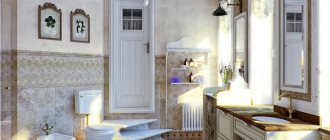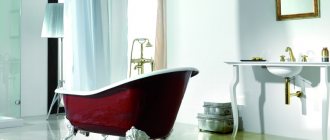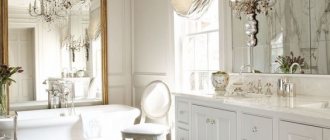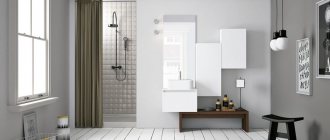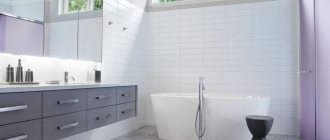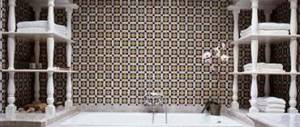The Art Deco style direction originated in France several centuries ago. Then this style was a little forgotten, but today it is again gaining its popularity and relevance. And in addition to the main living spaces, many people try to choose this unusual direction for the bathroom.
The characteristic features of this style are:
- use of expensive materials (ivory, silver, genuine leather, rare wood);
- color scheme of restrained tones (white, gray, beige, light purple);
- motifs that repeat the piano keys;
- predominance of sharp angles and curved lines;
- the presence of zigzags and stepped ascents;
- ornaments from the animal and plant world;
- images of sun rays.
In addition to such basic elements, the Art Deco style implies the use of patterns close to African and South American nationalities, an abundance of mirrors in luxurious frames, and a large number of vertical stripes.
Contrast
Color solutions in Art Deco design must be based on the use of contrast between two colors. The most common contrasting color pair is basic black and white. However, close to them are often used - dark gray, gray, beige, ivory. Shades from other spectrums of the color wheel, such as purple, pink and gold, are also used, but much less frequently.
The idea of contrasting basic colors should be supported not only by the decoration of walls, floors and ceilings, but also by the filling of the bathroom: plumbing fixtures, chandeliers, furniture, decorative elements. Additional colors that do not serve as primary (contrasting) colors should be muted and inconspicuous.
Photo:
Geometry
Squares and rhombuses, ovals and circles, angles, symmetry, planes, straight and broken lines - all this is found not only in geometry. This is also one of the foundations of Art Deco - the more geometry in the interior, the better. These motifs can be transferred to bathroom design. Most of the shapes of the style are regular geometric shapes, the use of which can be found not only in plumbing, but also in the design on the floor, in the shape of bedside tables and cabinets, in the shape of mirrors and chandeliers, in pronounced zoning planes.
Photo:
The secret of style and its features
The art deco direction can only be used in spacious rooms. The explanation for this is luxury, which will look uncomfortable in small rooms.
What are the distinctive features of the Art Deco style?
- The direction is characterized by broken and curved lines. This can be seen in absolutely every detail: ornament, method of laying tiles, form of ceiling and windows.
- A distinctive feature of the style is its rounded shapes, as well as the unusual depiction of flora and birds. The presence of sunlight, elements of oriental and even African decor in the interior emphasizes the style of the design direction in question.
- Interior solutions are filled with determination and courage, which indicates the complete incompatibility and absurdity of using different materials. A striking example would be to use chrome parts and ethnic compositions in the design.
- The basis of the style is based only on expensive and natural materials. Often, valuable wood and precious metals, as well as crocodile skin, are used to decorate and give a luxurious look.
- Refinement reigns in all details. The interior should not look vulgar.
- The bathroom design is full of rhythm, thanks to the clarity of the transitional contours, including the color scheme and texture of the materials used. The proof is the symbol of the art deco style in the form of piano keys.
- A distinctive feature of the style is the presence of natural and artificial light.
- The style is emphasized by suspended ceilings and huge mirrors.
Important: it is modern and relevant to decorate the bathroom with a glossy stretch ceiling, and use tiles with a glossy surface for the floor.
Patterns
Calculate the exact cost of repairs using an online calculator
and receive a free detailed estimate for repairs
Calculate
When decorating a bathroom in the Art Deco style, you can use not only geometric shapes, but also plant and animal patterns. This could be a mosaic or a painting on the wall, a pattern on the floor, elements of the edging of objects. The main thing is that the color schemes of the patterns also support the contrast of the main pair. You can use a living plant or an animal figurine as a small accent spot on a large area of one of the main colors.
Photo:
Color
This style can be called multifaceted and complex. Moreover, he has his own preferences regarding color directions. For example, dark chocolate and champagne are favorite colors.
In this case, color contrasts are possible, which should only be interspersed. Any object can take on this role. For example, a table. Bordeaux, cream or gold are also “favorites” of Art Deco.
The meaning of little things
The style chosen for decoration should be visible in everything, even in the smallest elements of the interior. When choosing a particular item for a bathroom in Art Deco design, you need to clearly understand where it will be located and whether it fits into the existing picture. Think about the proper placement of mirrors and accessories so that the room does not become cluttered and appears visually larger.
Photo:
Ready-made examples of bathroom design in Art Deco style
Art Deco is a style characterized by a variety of design ideas and solutions. To get acquainted with its features and draw up your own project for bathroom renovation, you should look at photos and videos of finished interiors from professional designers.
Mirrors
Any bathroom cannot do without mirrors. If in most bathrooms a mirror is an ordinary object, the presence of which is dictated rather by the purpose of the room, then in the Art Deco style the mirror is one of the main points on which the entire interior is built. It visually increases the space and also serves as another decorative element.
The main mirror of the room should either be large, framed by a wide massive frame, or it should completely occupy the entire wall or a geometrically designated place for it, for example a niche. For an Art Deco style mirror, it is also important to have an individual design that maintains the chic and gloss of the entire room.
If there are additional mirrors in the bathroom, they should be noticeably smaller than the main one and serve rather as a purely decorative element.
Photo: 69.media.tumblr.com
1/2
Photo: designingidea.com
2/2
Characteristic features of the art deco style
Style Features:
severity and symmetry of forms;
- non-standard and bold geometric lines;
- symmetry of interior compositions;
- the use of colorful ethnic patterns and ornaments;
- use of halftones;
- lack of bright colors;
- chevron and piano key motifs;
- A;
- the use of zigzag and stepped shapes;
- wide, energetic curves, sharp angles;
- animal, plant, solar motifs in design;
- the use of reflective, shiny, glossy surfaces;
- emphasis on luxury;
- the use of expensive modern materials: precious metals, rare woods, genuine leather, ivory, marble, enamel.
The attractiveness of the Art Deco style is due to the harmonious combination of luxury and pretentiousness of neoclassicism with the convenience and functionality of modernity. This feature has made it popular in the design of living rooms, including bathrooms, where it is important to rationally use a small space.
Most often in interior design there is a simple version of the style, leaning towards functionalism.
Color spectrum
Classic colors for Art Deco are black, white, gray. Gold and silver inclusions are widely used, helping to achieve the effect of high cost and luxury. For furniture, brown colors with wood stylization are used. This combination is traditionally considered a sign of high taste in European interiors.
In modern Art Deco the range is richer. To decorate walls, floors, and furniture, ivory color is used, as well as various shades of blue, green, lilac, pink, orange, cream, and sand. But they should be muted or whitened and not stand out from the general background. Red, purple, and blue tones are used to create bright accents.
Acceptable finishing materials
The style welcomes the use of expensive modern materials.
Among them:
A natural stone. The material is durable and reliable, and its aesthetic qualities fit well into the idea of style. For finishing the floors and walls, choose stone with a natural pattern, such as marble. Its simple but beautiful pattern pairs well with gold jewelry, glossy surfaces and other traditional style elements. For bathrooms, the most commonly used types of stone are granite and marble.
- Tile. A classic finish for the bathroom. The durable, moisture-resistant material comes in a wide variety of designs. The tiles are laid out in the form of patterns characteristic of Art Deco, most often geometric. Elements of diamond-shaped, hexagonal, triangular shapes are combined with rectangles and squares. The area near the bathroom or at the far wall is laid out with tiles with ornaments.
- Relief tiles. It has the same characteristics as simple tiles, but differs in a three-dimensional pattern on the surface. Most often used in finishing the ceiling or decorating certain areas of the room.
- Wallpaper with silk-screen printing. They look good due to their shiny glossy surface and pattern. They are not always comfortable in the bathroom due to frequent contact with moisture, so they are used only in large bathrooms, where it is possible to protect them from exposure to water and dampness.
- Porcelain tiles. An artificial material with characteristics similar to tiles, but characterized by better resistance to water and low weight. Available in various external variations: with patterns and designs, with imitation of natural wood or stone, etc. Suitable for implementing design solutions typical of Art Deco at a reasonable price.
- Microcement. An artificial material that looks like natural stone. Chaotic patterns and inclusions are visible on its surface, like on marble. It is durable, water-resistant, and creates a uniform, seamless coating. When decorating a bathroom, microcement is combined with wallpaper or relief tiles, because otherwise the interior turns out to be too boring or gloomy.
In Art Deco, there is often a combination of several different types of finishes: for example, marble floors and walls, a ceiling made of relief tiles and patterned tiles in the area next to the bathroom. In this version, all design elements are harmoniously combined with each other, creating a synthesis of modern functionalism and neoclassicism characteristic of the style.
An alternative option is a design in which the tile patterns on the floor, walls and ceiling overlap, forming a single composition.
It looks especially advantageous in large bathrooms.
Lighting accents
In the bathroom it is convenient to install several lamps for different work areas: near the mirror, washing machine, bathroom. Lamps built into the wall or ceiling are well suited for this purpose: they will emphasize the luxury and modernity of the interior, characteristic of Art Deco. An alternative is oblong wall lamps that imitate candlesticks or lanterns. They will give the room a charm based on a combination of ancient and modern.
You can hang a massive, ornate chandelier on the bathroom ceiling. This will emphasize the luxury of the interior. This solution looks especially impressive in spacious bathrooms with high ceilings.
Regarding the brightness and color temperature of lighting, lamps with warm (2500-3500 K) orange or yellow light are most suitable for an Art Deco interior.
They go well with an abundance of reflective surfaces and glossy elements, emphasizing muted colors.
Plumbing and furniture
Furniture for the bathroom can be either classic, modern or vintage, custom-made. The style allows you to combine functional minimalist elements with unusual and monumental ones.
It is better to choose plumbing fixtures for the bathroom from steel or acrylic. Items made of cast iron or natural stone, such as marble, will add originality and luxury. If the room area is large, a massive bathroom of an unusual shape with bold, sharp lines would look appropriate. It is placed in the center of the room, building the rest of the composition around it.
A bathtub with curved legs looks good in a small bathroom. It looks artsy and stylish, while at the same time combining with modern furniture.
A bathroom installed in a niche looks appropriate. This option combines luxury and convenience, simultaneously allowing for rational use of space and emphasizing the originality of the renovation. A niche is installed in the center of the room or against the wall, especially if there is a window on it: this gives the interior a special gloss and luxury.
If the bathtub is large and has an unusual design, it is better to choose simple, minimalistic shower stalls and toilets. Built-in appliances that blend into a wall or niche are perfect. An installation toilet with a button will add modernity to the interior. It will be complemented by a shower cabin with a metal or transparent door, a small bidet, and a sink with elegant rounded edges. Round and octagonal shapes, metal and chrome elements, identical patterns on different sanitary ware items will unite them into one picture.
It is better to choose modern household appliances (washing machine and dryer). If its design does not fit into the general idea of the room, the units can be hidden behind the doors of the cabinet-niche.
The selection of bathroom furniture depends on its area. In a small bathroom, shiny chrome shelves made of steel or aluminum, a small countertop, and neat hanging cabinets are appropriate. In a larger room you can install a floor cabinet, a dressing table with a chair. Furniture with rich facade decor is welcome: voluminous metal patterns, unusual handles, carvings, ornaments, inserts.
The originality of the bathroom design will be emphasized by the use of uncharacteristic pieces of furniture: a coffee table, chairs, armchairs. They should be elegant, with an unusual design, in which rounded or zigzag shapes predominate. The preferred material for furniture is natural stone or solid wood.
What accessories can be added?
Decorations and accessories are an important component of an Art Deco bathroom interior. They play a key role in creating an atmosphere of luxury and pretentiousness. Interesting decorative elements:
Mirrors. They visually expand the room and perform practical and aesthetic functions. In the interior design of the Art Deco style, large mirrors with heavy, wide frames made of expensive materials, decorated with carvings and ornaments are used. A reflective surface covering the entire wall looks appropriate. Mirrors of unusual shapes, with curls and sharp corners, such as beveled or with a frame in the shape of a sun, are good. Lighting will help add a modern touch to the interior.
- Decorative nozzles, taps, mixers. They are finished with various materials and decorated with carvings or figures. Marine themes and various elaborate patterns are popular. It is advisable that the decorations match the style of the handles of the cabinets and legs of the bathroom: this will create a feeling of integrity of the space.
- Fountain. It will add unusualness to the interior and emphasize luxury. Shiny jets of water will make the room brighter and fresher.
- Art objects. Figurines, vases, pendants will add additional chic to the interior.
- Paintings. Abstractions, images of animals and nature, photographs from the life of the city at night will appropriately dilute the interior. A wooden frame will add elegance, especially if it is matched to the mirror frame.
- Functional elements. Soap dishes, candlesticks, holders, towel rings, and hangers decorated and designed as objects of art will become excellent accessories for the bathroom.
- Podiums. Multi-level steps on the bathroom floor are one of the “features” of Art Deco. They emphasize the originality and boldness of forms and add unusualness. This decoration looks especially impressive if you install a niche bathtub on the podium.
- Textile. A bath mat is an essential decorative and functional element of any bathroom. It can be supplemented with various pillows, tapestries, towels, shower curtains made of fabric that matches the color and texture. Textiles for Art Deco are chosen to be luxurious, richly decorated, from expensive types of fabric or genuine leather.
- Curtains. If the bathroom has a window, it is best to decorate it with curtains made of heavy flowing fabric that forms beautiful folds. Several layers of tulle with alternating white and silver or golden shades would also be appropriate.
Natural flowers and plants look out of place in Art Deco, so it’s better to avoid them.
Exceptions include callas (Zantedeschia ethiopica), tropical ferns, and sakura branches.
Plumbing and furniture
Despite the style's bias towards geometry, plumbing fixtures and furniture in the bathroom can be of any shape. It is better if these are massive objects with smooth lines that support the main color pair. Along with the dimensions, it is also important that the plumbing is modern and high-tech. But we must not forget about its finishing. The base of the bathtub, facades and tabletops of furniture, supports are a huge field for the use of expensive materials and individual design solutions.
Photo:
Lighting
For lighting in bathrooms in Art Deco design, “classic” lamps are often used. A large pendant chandelier with many pendants and decorative ornaments or a geometric chandelier (sphere, square) is usually chosen as the main light source. Usually the main chandelier is made of expensive materials.
For additional lighting of individual areas, lamps that match the style are used, but there should be a minimum number of them.
Photo: i0.wp.com
1/2
Photo: wallmirrors.eu
2/2
Accents
If the size of the room allows, then to accentuate the style in the bathroom you can place an unusual item for it. This could be a chair, an ottoman, or a living plant. It is important to remember that if this is a piece of furniture, then it should be elegant, made of expensive materials. If a chair or ottoman can stand out in the surrounding environment and be a bright accent spot, then the decorative plant should be selected very carefully. On the one hand, it should not contrast strongly with the general background of the place where it will be installed, on the other hand, it should also attract attention.
Photo: trend4homy.com
1/2
Photo: nouvellesideesdecoration.com
2/2
Accessories
Small but significant details perfectly complement the interior.
- An artificial fountain and its imitation are a unique and stunning accessory for interior decoration.
- The not bulky, abstract statue harmonizes expressively in the overall composition.
- A colorful photograph of skyscrapers in New York or other cities will add a touch of freshness to the interior.
It should be emphasized that dental accessories and cosmetics cannot be left in a visible place; only 2-3 bottles in front of the glass can be placed in plain sight. Otherwise, it will destroy the harmony of the interior.

